Jul 06, 2015
With Pollution Levels Dropping, is Small Particle Air Pollution Really Killing Americans?
By Steve Goreham
Originally published in Communities Digital News.

Unnoticed by most citizens, last week the United States Senate introduced the “Secret Science Reform Act of 2015.” The act is aimed at the Environmental Protection Agency’s practice of refusing to disclose data from scientific studies that support new pollution regulations. The act indirectly questions the EPA assertion that Americans are dying today from small particle air pollution.
Past EPA Administrator Lisa Jackson testified before Congress in 2011, stating, “Particulate matter causes premature death. It doesn’t make you sick. It’s directly causal to dying sooner than you should.” Particulate matter refers to PM2.5, classified by the EPA as particles smaller than 2.5 microns in diameter, much smaller than the eye can see. Particle pollution is a mixture of dust, nitrates and sulfates, metals, pollen, and organic chemicals.
The EPA claims that any level of small particles can cause premature death. The agency warns that death may be short-term, occurring within a few hours of inhalation, or may be caused by long-term inhalation of PM2.5 over several years. EPA policy advisor Amanda Brown asserted that between 130,000 and 320,000 Americans died prematurely in 2005 due to small particle pollution, an incredible 6 to 15 percent of total US deaths.
EPA claims that particle pollution triggers heart failure, respiratory failure, or other causes of death. For example, suppose a senior citizen dies a few days before his 67th birth day and a coroner determines heart failure to be the cause of death. According to the EPA, the death may have been “premature” and caused by small particle air pollution.
The EPA uses “prevention” of premature deaths from small particles to justify tighter pollution regulations. The EPA’s proposed Clean Power Plan, which will force closure of coal-fired power plants across the nation, is an example. The EPA claims that implementation of the CPP will prevent up to 6,600 premature deaths and $93 billion in climate and public health benefits. But the monetized climate benefits are essentially zero. Almost all of the $93 billion comes from an EPA calculation on savings from avoidance of premature death from small particles.
_thumb.jpg)
Enlarged
Today, our nation’s air is remarkably clean, especially when compared to 50 years ago. Incidents of serious air pollution are rare. According to the EPA, the concentration of six major air pollutants, lead, nitrous oxides, sulfur dioxide, ozone, and particulates, are down more than a combined 70 percent since 1980. PM2.5 particle pollution is typically below the EPA national standard of 15 micrograms per cubic meter of air.
Fifteen micrograms per cubic meter is not very much. Dr. James Enstrom, retired researcher from the UCLA School of Public Health, points out that a person breathing in 15 micrograms of small particles per cubic meter would inhale only about one teaspoon of these microscopic particles over an 80-year lifespan. The EPA’s assertion that this small amount of particles causes premature death is not credible.
How does the EPA conclude that thousands of Americans die each year from particle pollution? No coroner ever attributes a cause of death to particle pollution. Instead, the EPA relies on epidemiological observational studies that associate particle pollution with death.
Epidemiological studies analyze statistical associations between exposure to an agent and appearance of disease in a population. An example is the Doll and Hill study in the 1950s that found that cigarette smoking caused lung cancer in a population of 41,000 British medical doctors. EPA has concluded that associations found in epidemiological studies show that inhalation of small particles cause premature death.
But the association between death and particle pollution found by studies that EPA relies on is shaky at best. Relative risk (RR) is the ratio of incidence of disease in an exposed population to a control population. The size of the relative risk is a measure of the chance that an association is causal.
The Harvard Six Cities study of 1993 and the American Cancer Society study of 1995, two studies that form the basis of EPA small particle science, found an increase in relative risk of less than 20 percent (RR=1.2). An increase in death rates of less than 20 percent (RR=1.2) is almost statistically indistinguishable from zero. In contrast, the Doll and Hill study on cigarettes and lung cancer found smokers had 10 times the rate of lung cancer and non-smokers, a relative risk of RR=10. The weak association (small relative risk) between death and particle pollution that the EPA judges to be causal could be due to other factors in the measured populations or even random chance.
But what stinks to high heaven is that data from the Harvard Six Cities and American Cancer Society studies have never been released. Other scientists are not able to replicate and verify the results of these studies. In effect, the EPA is asking all to “trust us” on the science of death from particle pollution. The Secret Science Reform Act proposes to force the EPA to disclose data from studies that support the need for EPA regulations.
Further, EPA is often the funding agency for epidemiological studies that are then used to justify new air pollution regulations. EPA supports such studies either directly or indirectly through grants to organizations such as the American Lung Association and the American Cancer Society. For example, over the last decade the EPA has provided more than $20 million in grants to the American Lung Association, a group that supports EPA efforts for more stringent air pollution regulations (payback was the ads they ran unsupported by the data).
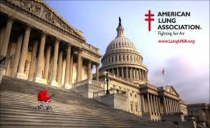
The result is a massive, costly, and growing burden on American citizens in the name of clean air. NERA Economic Consulting estimates that the Clean Power Plan will cost US citizens some $400 billion in compliance costs over the next 15 years. But the savings from “prevention of premature deaths” from particle pollution are likely imaginary.
Steve Goreham is Executive Director of the Climate Science Coalition of America and author of the book The Mad, Mad, Mad World of Climatism: Mankind and Climate Change Mania.
Jul 05, 2015
Winters not Summers increase Mortality and Stress the Economy - next mini-ice age approaching?
Joseph D’Aleo and Allan MacRae
Warmists and their compliant media reporters continue to stress the danger of heat and ignore cold in their papers and in stories.
The danger associated with this misdirection is that cold weather kills 20 times as many people as hot weather, according to an international study analyzing over 74 million deaths in 384 locations across 13 countries. The findings were published in The Lancet.
“It’s often assumed that extreme weather causes the majority of deaths, with most previous research focusing on the effects of extreme heat waves,” says lead author Dr Antonio Gasparrini from the London School of Hygiene & Tropical Medicine in the UK.
The study analyzed over 74 million (74,225,200) deaths between 1985 and 2012 in 13 countries with a wide range of climates, from cold to subtropical. Data on daily average temperature, death rates, and confounding variables (eg, humidity and air pollution) were used to calculate the temperature of minimum mortality (the optimal temperature), and to quantify total deaths due to non-optimal ambient temperature in each location.
Around 7.71% of all deaths were caused by non-optimal temperatures, with substantial differences between countries, ranging from around 3% in Thailand, Brazil, and Sweden to about 11% in China, Italy, and Japan. Cold was responsible for the majority of these deaths (7.29% of all deaths), while just 0.42% of all deaths were attributable to heat.

Enlarged
According to Dr Gasparrini, “Current public-health policies focus almost exclusively on minimizing the health consequences of heat waves. Our findings suggest that these measures need to be refocused and extended to take account of a whole range of effects associated with temperature.”
THE UK
The UK Guardian looked at Excess Winter Mortality after the 2012/13 hard winter.
They used data from the ONS. Each year since 1950, the UK Office for National Statistics or ONS has looked at excess winter mortality. The ONS take an average of deaths in winter (those in December to March) and subtract the average of non-winter deaths (April to July of the current year and August to November of the previous year). The result is considered ‘excess’.
Like other European countries, more people die in the UK in winter than in summer. Some 58% of winter excess deaths were women, a trend that has been quite consistent over the past three years. Circulatory diseases were cited as the biggest cause of winter deaths (accounting for 37%), closely followed by respiratory diseases (32%). Unsurprisingly, the majority of deaths occur with older people - specifically those aged 75 and above.
See paper on UK Excess WInter Mortality here.
“The impact of cold weather on health is predictable and mostly preventable. Direct effects of winter weather include an increase in incidence of: heart attack; stroke; respiratory disease; flu; falls and injuries; hypothermia. Indirect effects of cold include mental health illnesses such as depression, and carbon monoxide poisoning from poorly maintained or poorly ventilated boilers, cooking and heating appliances and heating.” Department of Health (2012) Cold Weather Plan for England.
In normal milder western and southern Europe, the Excess Winter Mortality is greater than in the colder northern climates, where people are more accustomed to colder winters and homes are built to keep the residents warmer (better insulated, central heating). Also energy costs there are far higher thanks to the early adoption of the inefficient and much more expensive renewable energy.
The UK reported 50,000 excess deaths in the UK in 2012/13. Excess Winter Mortality was 31,100 in England and Wales in up 29% from the previous year. Figures for Scotland showed a much smaller increase in winter deaths, up 4.1% to 19,908. In Northern Ireland meanwhile, the raw numbers were low but the increase was large, a rise of 12.7% to 559 deaths.
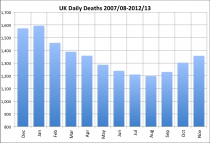
Enlarged
UNITED STATES
Similarly, the USA death rate in January and February is more than 1000 deaths per day greater than in July and August.
Indur M. Goklany wrote in 2009: “Data from the US National Center for Health Statistics for 2001-2008, shows that on average 7,200 Americans died each day during the months of December, January, February and March, compared to the average 6,400 who died daily during the rest of the year. In 2008, there were 108,500 ‘excess’ deaths during the 122 days in the cold months (December to March).”
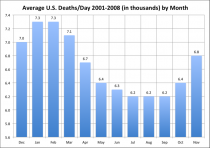
Enlarged National Center for Health Statistics
Despite claims that extreme heat in increasing and cold decreasing, the data says the un-manipulated state extreme temperature data shows the opposite.
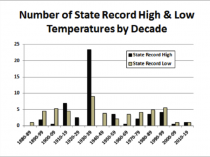
Enlarged
23 of the state all-time record highs occurred in the 1930s and 38 before 1960. There have been more record lows since the 1940s than record highs.
CANADA
Statistics Canada also reports deaths by month. The graph below shows the deaths per day for each month in Canada averaged over the years 2007 - 2011.
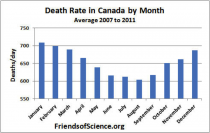
Enlarged
The graph shows that the death rate in January is more than 100 deaths/day greater than in August. See more here.
AUSTRALIA
Even down under in Australia we see the same story. Queensland University of Technology found (Source Science Daily) Australians are more likely to die during unseasonably cold winters than hotter than average summers.
Across the country severe winters that are colder and drier than normal are a far bigger risk to health than sweltering summers that are hotter than average.
QUT Associate Professor Adrian Barnett, a statistician with the Institute of Health and Biomedical Innovation and the lead researcher of the study, said death rates in Australian cities were up to 30 per cent higher in winter than summer.
The researchers analyzed temperature, humidity and mortality data from 1988 to 2009 for Adelaide Brisbane, Melbourne, Perth and Sydney.
Professor Barnett said the finding that hotter or more humid summers had no effect on mortality was “surprising.” “We know that heat waves kill people in the short-term, but our study did not find any link between hotter summers and higher deaths,” he said.
EXCESS WINTER ECONOMIC IMPACT
There’s something that befudles economists and the administration about the U.S. economy in the first three months of every year: It frequently grows at a much slower pace than in the other nine months. The below academic paper, authored by the Federal Reserve Of Chicago, validates the growing link between advancing cold and its impact on economies. From slowing money velocity to low bond yields and reduced consumer spending, behavioral economics are well documented here and offer implicit confirmation that not only is the planet not warming but that cold weather is partially responsible for the slow economic recovery following the 2008 economic crisis. As the Federal Reserve grapples with interest rate policy, the credibility of U.S. dollar may be at stake. Investors worldwide evaluate it’s health with the U.S. treasury market a proxy, roiled recently by a sequence of Federal Reserve revised Gross National Product numbers. We ask this question: were initial strong first quarter GDP numbers during the past several years skewed by faulty reporting of mild winter weather, then later adjusted lower by the impact of under reported cold weather? The implications of such divergences are enormous to world markets.
Alec Phillips, an economist at Goldman Sachs, noticed that from 2010 through 2014, growth in the first three months of the year has averaged 0.6 percent, while it has averaged 2.9 percent in the other three quarters.
And Macroeconomic Advisers, a forecasting firm, has found that the pattern goes back further: Since 1995, outside of recessions, the first quarter has grown at half the pace of the other three.
The government agency charged with calculating the economy’s growth rate said it would adjust its methods in an effort to resolve the problem. While other economists, including at the Federal Reserve in Washington, have concluded that the government’s figures are largely accurate. The first-quarter weakness over the years is in part due to to harsh winter weather. Source
See the new Federal Reserve study on the effect of cold on the economy here. See also here how BofA and some FED divisions had scoffed at cold weather impacts but are seriously lobbying to have government adjust GDP numbers to come better in line with their bad forecasts.
---------
Met Office Issues Warning That Temperatures Could Plummet As Sun Enters Cooler Phase
UK Daily Mail
Britain could be on the verge of a mini Ice Age as the Sun enters a cooler phase, the Met Office warned yesterday. The last big chill was felt hundreds of years ago when Frost Fairs were held on the frozen River Thames.
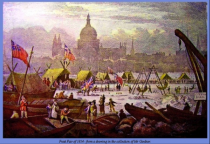
Enlarged
However the Met Office said the new freeze will not be enough to cancel out the effects of global warming.
Met Office’s Hadley Centre, which looks at long term forecasts, said there was a 15-20 per cent chance that we could match the temperatures last seen in 1645-1715 - sometimes called the Little Ice Age - when the River Thames froze over.
This could take place at some point within the next 40 years.
The prediction is based on counting sun spots - dark patches on the sun - that are hot spots and signs of increased solar activity.
The decrease in the sun’s heat is known as a ‘Maunder minimum’ after Walter Maunder - the astronomer who first noted sunspots were at their lowest during the cold period between 1645 and 1715.
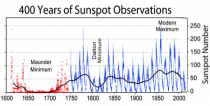
Enlarged
Studies by the Met Office and others have found a decrease in sun spots - suggesting the sun may be going through a cooler phase.
The cooling effect is expected to be strongest in northern Europe, the UK and eastern parts of North America - particularly during winter. For example, for northern Europe the cooling is in the range -0.4 to -0.8C.
Jul 04, 2015
Food for all
Scientific Alliance
Although not a household name, Sir Fazle Hasan Abed is credited with helping tens of millions of people in poor countries; for this, he has been awarded the 2015 World Food Prize (Anti-poverty pioneer wins 2015 World Food Prize). The organisation he founded as the Bangladesh Rural Advancement Committee in the early 1970s has become BRAC, the largest development organisation in the world, operating in 11 countries in Asia, Africa and the Caribbean.

To quote from the organisation’s website, “BRAC...catalyses lasting change, creating an ecosystem in which the poor have the chance to seize control of their own lives. We do this with a holistic development approach geared toward inclusion, using tools like microfinance, education, healthcare, legal services, community empowerment, social enterprises and BRAC University. Our work now touches the lives of an estimated 135 million people...”
The World Food Prize was established in 1987 by Norman Borlaug, whose development of dwarf rice and wheat varieties ushered in the Green Revolution which proved the predictions by Ehrlich and others of a Malthusian catastrophe comprehensively wrong (or simply ahead of their time, depending on your point of view). Borlaug received the Nobel Peace Prize for his work, and instituted the World Food Prize to recognise “outstanding individuals who have made breakthrough achievements contributing to improving the quality, quantity or availability of food throughout the world”.
Food insecurity often does not get the attention it truly deserves, except in the case of devastating local famines. But it underlies our entire civilization. If life is simply a struggle to get enough food to survive, people’s potential contribution to society is almost completely snuffed out. BRAC addresses this in particular by empowering women. As Sir Fazle says “Only by putting the poorest, and women in particular, in charge of their own lives and destinies, will absolute poverty and deprivation be removed from the face of the Earth.”
His organisation’s role is broader than simply ensuring people have sufficient food, but this is the first basic need fulfilled when people lift themselves out of poverty. With enough nutritious food, adults can work productively. Well-nourished mothers give birth to babies of normal weight. Well-fed infants avoid stunting and develop both physically and mentally into healthy, productive adults.

All of this is good, but it also introduces a philosophical dilemma. As people no longer struggle to survive day to day, they want more out of life and they want a better life for their children. It isn’t possible just to turn struggling subsistence farmers into well-fed subsistence farmers. Some will develop businesses, small farms will coalesce into larger, more productive ones and many people will leave the land for a new life in the city.
Society will change, and today’s poor people will want the same things that today’s rich countries enjoy. Not that the path of development will necessarily be identical. For example, it is becoming obvious that many developing countries are by-passing fixed-line telephone networks almost entirely and adopting mobile phones for internet access as well as calls. Similarly, a distributed electricity supply to rural areas may be difficult to deliver in the short term, so there is a real role for small-scale solar power, at least in the interim.
But all this relies on people being able to feed themselves properly. A recent Economist analysis (Is the world running out of food?) shows that sufficient food is being produced to feed today’s population, but points out the problems associated with increasing harvests by perhaps a further two-thirds to feed nine billion increasingly prosperous people by mid-century.
It is widely recognised that this is not just about farmers producing enough food. Crops also have to be delivered to consumers in good condition. In the rich world, there is a large amount of food wasted in the home - one of the downsides of prosperity - but poor roads, lack of refrigeration and attacks by pests mean that a significant amount of food harvested in developing countries never reaches the consumer at all.
Growing enough food and avoiding waste are both important, but so is affordability. Poor people who do not grow enough of their own food often don’t have any money to buy more. This is where helping people lift themselves out of poverty is so important. Once that first step on the development ladder has been taken, there is a natural build-up in momentum which transforms societies. It has already happened in the south-east Asian ‘tiger economies’. We are witnessing it in China today, and tomorrow even the poorest countries in Africa will hopefully be set on the same path.
These changing societies will have an impact on their environment; whether this is negative, positive or neutral is in the eye of the beholder. What we do know, however, is that more prosperous societies value the natural environment more and are more willing to spend to improve water and air quality and conserve species.
One of the consequences of these trends is what has become known as ‘sustainable intensification’ of farming. The aim is to produce more food from the same area of land, so avoiding further encroachment on natural habitats. The modern ‘industrialised’ and globalised food chain is anathema for supporters of the rich world fashion for organics and localism, but the reality is that this is the only way to global population will be properly fed.
Another consequence is the increasing importance of large multinational businesses in supplying seed and other farming inputs. The present handful of companies is likely to become even more concentrated, with Monsanto trying hard to take over Syngenta and, failing that, having the agricultural division of Bayer in its sights. But their dominance of the start of the food chain is only made possible because they provide better seeds and crop protection methods than smaller competitors. Farmers make a free choice.
In fact, the supposed dominance by the big six agricultural supply companies is the subject of an interesting perspective in a Forbes article: Who controls the food supply?, in which the author makes a case for the influence of the anti-GMO activist lobby being at least as strong. Whatever the rights and wrongs of this, the system delivers at the moment and innovation and free markets look set to continue to deliver for the foreseeable future. In the meantime, congratulations to BRAC for making a difference to the lives of so many people.
Jun 06, 2015
India Monsoon Predictably Slow Onset due to El Nino and cool, wet spring
Joseph D’Aleo, CCM
UPDATE:
The monsoon rains came hard though as predicted delayed to western India. Meanwhile to the west in Pakistan the seasonal pre monsoonal heat was the news story. Power outages in the poorer areas caused deaths. Notice in the CNN story, the heat wave comes at a time when this predominantly Muslim country’s citizens are observing Ramadan. During the holy month, the faithful fast from sunup until sundown.
This means that, amidst these scorching temperatures, Pakistanis are forgoing food and water. Clerics are reminding residents that they can forego fasting if they feel the soaring temperatures are life-threatening.
The Ramadan holydays float during the years. It is untimely when it comes during the seasonal pre-monsoonal heat. See how temperatures peak in Pakistan as in India before the rains come.
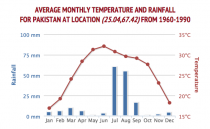
Enlarged
-----------
El Ninos historically have been associated with erratic and less productive monsoon rains in India, Indonesia and often parts of Australia. The red circles represent El Nino years Most were below normal to normal for precipitation. La Ninas are normally wet (blue circles).
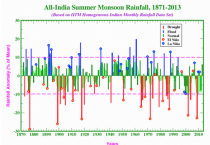
Enlarged
See the temperature and precipitation patterns associated with El Nino and La Nina. We know there are different flavors of El Nino related to strength and where in the Tropics, waters are warmest.
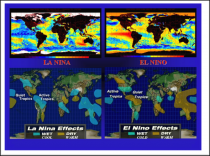
Enlarged
The media has promoted the pre monsoonal heat as unprecedented and surely the result of global climate change.
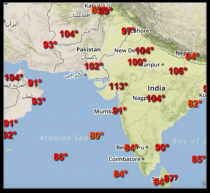
Enlarged
Normally the heat peaks in the spring which helps draw in monsoon moisture when the jet stream lifts north of the Himalayas, starting by early June.
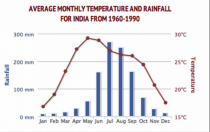
Enlarged
The monsoon is 5 days late into the south in Kerala and is proceeding north. The normal monsoon front is shown in the red dashed line. The green is actual as of June 5th.
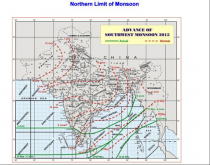
Enlarged
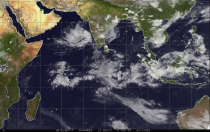
Enlarged
Temperatures in India were well below normal this winter and most of spring and it was unusually wet. This is the departure from normal for December through April.
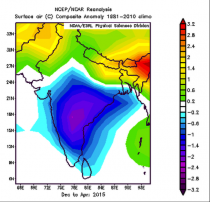
Enlarged
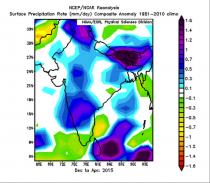
Enlarged
The cooler April and early May combined with El Nino to favor a delayed and likely erratic monsoon year. The heat that appears in April and May usually helps draw in moisture from the Indian Ocean when the jet stream lifts north of the Himalayas. We have been telling our clients that for months.
The heat came on late and the rains have followed suit.
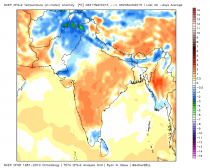
Enlarged
Is that heat and monsoon disruption new - hell no - Sir Gilbert Walker went to India in 1904 to try and find out why the monsoon failed in some years (like 1899) and he found the Southern Oscillation ( SOI - a pressure flip flop Darwin to Tahiti) that much later (1960s by Rossby) was connected with the ocean temperatures in El Nino Southern Oscillation (ENSO). 113.7F is not at all unprecedented. When you delay the monsoon and have the heat come late closer to the maximum solar (when the sun is overhead over India), it gets hotter than normal in June.
The media was all abuzz about the 3000 plus heat deaths from the late May early June heat in India. A recent Lancet article showed 20x more people die in winter cold than summer heat. We would bet that 20-30,000 people died this winter in India from the cold.

Enlarged
WHAT’S AHEAD
The European 30 day mean forecast is for wetter and cooler weather to return. Expect to hear about the localized flooding that will occur and yes how it is unprecedented (it’s not).
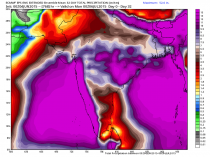
Enlarged
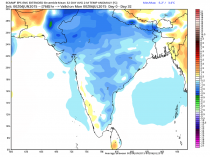
Enlarged
A tropical storm is developing in the Arabian Sea west of India. It is forecast to move north northwest. it should pump some moisture into the hot west central although the models suggest the heaviest rains are west of the western Ghats mountains.
_thumb.jpg)
Enlarged
Jun 02, 2015
Climate change: Mr. Obama, 97 percent of experts is a bogus number
By Richard Tol, IPCC Lead Author
Ninety-seven percent of scientists agree: Climate change is real, man-made and dangerous. President Obama tweeted that, and it has been repeated by countless others. It is tempting for a politician to claim that 97 percent of experts agree with you. But do they?
The 97 percent claim was taken from a study paper by Australian John Cook, Climate Communications Fellow for the Global change Institute at the University of Queensland, and his colleagues, published in the journal Environmental Research Letters in May, 2013. The paper says nothing about the would-be dangers of climate change and it counts the number of publications, rather than the number of scientists, in support of human-made climate change. Never let facts get in the way of a good story.
The paper is a treasure trove of how-not-to lessons for a graduate class on survey design and analysis: the sample was not representative, statistical tests were ignored, and the results were misinterpreted.
What was an incompetent piece of research has become a highly influential study, its many errors covered up.
Some of the mistakes in the study should be obvious to all. There are hundreds of papers on the causes of climate change, and thousands of papers on the impacts of climate change and climate policy. Cook focused on the latter. A paper on the impact of a carbon tax on emissions was taken as evidence that the world is warming. A paper on the impact of climate change on the Red Panda was taken as evidence that humans caused this warming. And even a paper on the television coverage of climate change was seen by Cook as proof that carbon dioxide is to blame.
Cook and Co. analysed somewhere between 11,944 and 12,876 papers - they can’t get their story straight on the sample size - but only 64 of these explicitly state that humans are the primary cause of recent global warming. A reexamination of their data brought that number down to 41. That is half a per cent or less of the total, rather than 97 percent.
The remainder of Cook’s “evidence” is papers that said that humans caused some climate change and, more importantly, papers that Cook’s colleagues thought said as much.
There is vigorous debate about how much humans have contributed to climate change, but no one argues the effect is zero. By emitting greenhouse gases, changing the landscape, rerouting rivers, and huddling together in cities, we change the climate - perhaps by a little, perhaps by a lot - but not one expert doubts we do. However, a true consensus - 100 per cent agreement - does not serve to demonize those experts who raise credible concerns with the state of climate research.
The trouble does not end there. Cook has been reluctant to share his data for others to scrutinize. He has claimed that some data are protected by confidentiality agreements, even when they are not. He was claimed that some data were not collected, even when they were. The paper claims that each abstract was read by two independent readers, but they freely compared notes. Cook and Co. collected data, inspected the results, collected more data, inspected the results again, changed their data classification, collected yet more data, inspected the results once more, and changed their data classification again, before they found their magic 97 percent. People who express concern about the method have been smeared.
We would hope that the president of the United States of America does not spend time checking such trivia. That is the job of the editor of the journal, Dan Kammen of the University of California at Berkeley, who unfortunately has chosen to ignore all issues I and others raised about them. Similarly, the journal’s publisher, the Institute of Physics, and Cook’s employer, the University of Queensland, have turned a deaf ear to my concerns. What was an incompetent piece of research has become a highly influential study, its many errors covered up.
And for what? If Cook’s results are to be believed, 97 percent of experts agree that climate change is real and largely human-made. This does not tell us anything about the risks of climate change, let alone how these compare to the risks of climate policy.
That is a difficult trade-off, and it should be informed by the best possible science rather than dodgy work like Cook’s.
Richard Tol is a professor of economics at the University of Sussex and the Vrije Universiteit Amsterdam. He has been involved in the IPCC since 1994.
|

_thumb.jpg)


























_thumb.jpg)